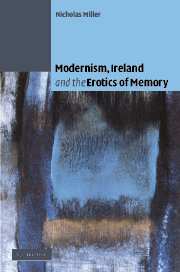Book contents
- Frontmatter
- Contents
- List of illustrations
- Acknowledgments
- Introduction. All history is local: modernism and the question of memory in a global Ireland
- Part I THE EROTICS OF MEMORY
- Part II THE SPECTACLES OF HISTORY
- 4 The birth of a nation: Irish nationalism and the technology of memory, 1891–1921
- 5 Fighting the waves: Yeats, Cuchulain and the lethal histories of “romantic Ireland”
- 6 Joyce's erotics of memory: temporal anamorphosis in Finnegans Wake
- Afterword. The ends of memory and the ex-sistence of Ireland
- Notes
- Bibliography
- Index
6 - Joyce's erotics of memory: temporal anamorphosis in Finnegans Wake
Published online by Cambridge University Press: 22 September 2009
- Frontmatter
- Contents
- List of illustrations
- Acknowledgments
- Introduction. All history is local: modernism and the question of memory in a global Ireland
- Part I THE EROTICS OF MEMORY
- Part II THE SPECTACLES OF HISTORY
- 4 The birth of a nation: Irish nationalism and the technology of memory, 1891–1921
- 5 Fighting the waves: Yeats, Cuchulain and the lethal histories of “romantic Ireland”
- 6 Joyce's erotics of memory: temporal anamorphosis in Finnegans Wake
- Afterword. The ends of memory and the ex-sistence of Ireland
- Notes
- Bibliography
- Index
Summary
I beg you … not to try to understand too much of what I tell you.
Sigmund Freud “The Dream-Work” Introductory Lectures on Psycho-AnalysisAmong the most beguiling passages in Finnegans Wake is that in which the text relates its own myth of historical origin. A literary version of the paradigmatic chicken and egg conundrum, the passage recounts the discovery by an “original hen” of a letter which contains the Wake in microcosm and, implicitly therefore, the hen and her discovery as well. After some necessary distilling, the passage reads as follows:
About that original hen. Midwinter … was in the offing and Premver a promise of a pril when … an iceclad shiverer … observed a cold fowl behaviourising strangely on that fatal midden … (dump for short)…. The bird in the case was Belinda of the Dorans … and what she was scratching at the hour of klokking twelve looked for all this zogzag world like a goodish-sized sheet of letterpaper.
(Joyce, FW, 110.22–111.9)The exhumed letter, fragments of which the passage goes on to quote, is, like the Wake itself, only partially legible; its content (something about a funeral) is ultimately obscure, as are the identities of both its addressee (one “Maggy”) and its author (in place of a signature one finds only a tea stain: “affectionate largelooking tache of tch. The stain, and that a teastain … marked it off“ [Joyce, FW 111.15–18]).
- Type
- Chapter
- Information
- Modernism, Ireland and the Erotics of Memory , pp. 153 - 185Publisher: Cambridge University PressPrint publication year: 2002



